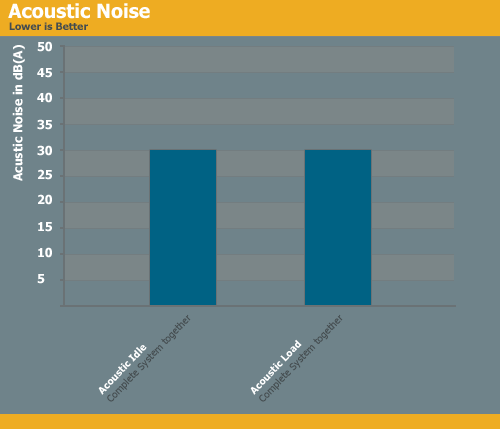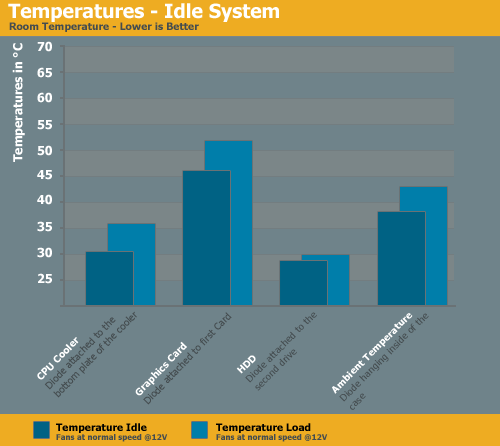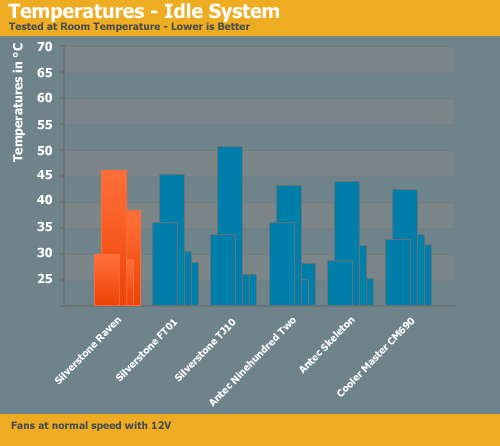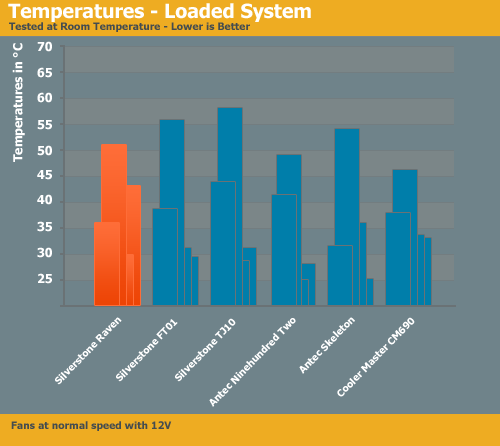
Original Link: https://www.anandtech.com/show/2720
Silverstone Raven: A New Concept in Case Cooling
by Christoph Katzer on February 6, 2009 4:00 AM EST- Posted in
- Cases/Cooling/PSUs
Introduction
Silverstone has had some interesting innovations for its customers, for example the FT01 designed for optimal cooling using positive air pressure. Today we are looking at another new cooling concept from Silverstone. Just as positive air pressure is nothing revolutionary -- search through any tech forums and you're likely to see some discussions about the topic -- the new concept with this case is that Silverstone change the direction the motherboard faces. Instead of having the I/O ports on the back, they will now be at the top of the case. If that immediately makes you worry about wires cluttering things up, don't: Silverstone has a cover to help keep the look clean.

The case looks like it came directly from the Transformer factory, and that's likely something you will either love or hate. Silverstone told us that the general feedback from customers so far is very good, and since the case is already available they apparently have sales to back up that statement.
As far as changing the direction the motherboard faces, the goal is simple. Silverstone wants to use a chimney stack effect where cool air comes in at the bottom and naturally flows upwards -- hot air rises. By designing a case where all of the air enters at the bottom and flows out the top, cooling should be improved and perhaps noise levels will be reduced at the same time. There are still fans to help out, but the natural airflow will hopefully reduce fan speeds. We can't actually prove that the stack effect is better or worse than other cases, since this case is only designed to work with the effect being active.
Silverstone has invested a great deal of time explaining how different cooling effects work, which you can see on YouTube and their own internal website:
Stack Effect Cooling (YouTube video)
Positive Air Pressure (YouTube 1, YouTube 2)
| Silverstone Raven Specifications | ||
| Motherboard Formfactor | ATX, Micro ATX, Extended ATX | |
| Drive Bays | External | 5x 5.25" |
| Internal | 6x 3.5" | |
| Cooling | Front | - |
| Rear | - | |
| Top | 1x 120mm exhaust | |
| Side | - | |
| Bottom | 2x 180mm intake | |
| Expansion Slots | 7 | |
| Front I/O Port | 2x USB, 1x Audio, 1x Micro , 1x IEEE1394 | |
| Power Supply Size | Standard ATX | |
| Weight | 15kg | |
| Dimensions | 280 x 616 x 660 (WxHxD in mm) | |
Now let's see if this case can actually live up to Silverstone's promises and stand out from the crowd.
Appearance

The case is all matte black with small windows on the left side panel where users can see their motherboard and components. We are rather pleased that Silverstone didn't include a larger window, since this allows you to show off your graphics card(s) and a few other items without worrying about showing the power supply and all of the extra cables that might be present. The top of the case is rather bulky, since there needs to be room for all of the cables that would normally be at the back of your case. The left side also features additional air intakes that bulge out on the bottom of the case; in fact, the case is somewhat reminiscent of HP's Blackbird design, with some obvious changes. The front of the case sports a horizontal clear plastic part at the top that glows blue when the system is powered up. If you use the appropriate motherboard connector, you also see a small red flashing light in the middle of the blue illuminated bar for hard drive accesses.
The front door is quite cool: it slides down into a recess when you push it. It will stay there until you tap it again, at which time it will slowly slide up to its starting position. Above the door in the horizontal glowing bar you find the power and reset buttons. Behind these buttons is a door that you might not at first notice, which provides access to some standard I/O ports -- USB, audio, and FireWire.
Moving to the rear of the case, things take a dramatic turn from what we are used to. You are greeted by a smooth surface, since all the connectors are now at the top of the case. The one exception is the power supply, which is located at the bottom of the chassis. We think this design will appeal particularly to people who have their PCs sitting next to (or under) their desk on the floor. It's possible to hide much of the cable clutter that you would normally see if you're careful. Of course, the flipside is that you would want to have this case sitting on top of something like your desk, as then everyone would see all of the cables hanging down from the top of your chassis.
Opening the top of the case to get all of the cables and expansion ports is very easy. You turn both knobs at the back of the top and then you can lift that part out of the way. You will then have access to all of the expansion slot ports. The removable section is perforated to allow airflow through the top of the chassis, and in fact airflow would probably be better if this perforated top didn't even exist (although then we wouldn't have hidden cables). You'll also need to remove the top panel anytime you want to access the side panels, since the two lovers that open the sides are underneath the top panel. When you push the appropriate lever towards the front, the respective side panel will open.
Another noteworthy feature is that Silverstone installed filters on all of the air intakes, which should help tremendously in keeping the interior of your case free of dust bunnies. Since the case will likely be sitting on the floor, this is an even bigger concern. Just remember to clean your air filters on a regular schedule.
Inside
The case design concept is indeed very different, and even if the cooling isn't any better there are almost certainly people that would still approve of this case design. However, we think that the cooling design is effective, since heat should exhaust easier through the top of the chassis. You can also get fresh air for some important components without having to draw air through the entire chassis; for example, a power supply with a 120mm fan on the bottom gets direct access to fresh air. Higher end GPUs should also get access to a lot of fresh air from the side panel vents. A 120mm fan serves as the primary exhaust at the top of the case, and Silverstone again uses positive air pressure with more intake fans than exhaust fans in order to optimize cooling.

Towards the front of the case are six hard drive cages that can be removed by opening the appropriate lever and sliding them out. This allows you to easily install hard drives, and small rubber grommets isolate the hard drives and keep them from touching the rest of the chassis. This should reduce vibrations and thus decrease noise levels. The drive bay on the left includes a back plate that enables hot swapping of that hard drive. Optical drives use the same mounting system Silverstone has used in other cases.
One of the interesting benefits of the case design is that you shouldn't have to worry as much about graphics cards causing flex on your motherboard. They can now hang from the top of the case and shouldn't sag. In addition, you can use a support bar that reaches across the motherboard to help secure the graphics cards. The bottom of the case has a ton of space, so you can easily install even the longest of power supplies. The air filters at the bottom are easily removed for cleaning, although you will need to remove the side panel for some of the filters. Finally, there's a bit of extra room behind the motherboard where you can route some smaller cables if you desire, but it's not a particularly large area so you won't be able to route all of the cable harnesses that way.
Test Setup
| Test Configuration | |
| CPU | Intel Core 2 Extreme QX6850 (Quad-core 3.0GHz, 2x6MB L2, 1333FSB) |
| Motherboard | Asus P5N-T Deluxe |
| Graphics Cards | Triple-SLI NVIDIA GeForce 8800 Ultra |
| Memory | 4GB OCZ DDR2 PC2-8500 Platinum Series |
| HDD | Western Digital WD4001ABYS (Fully equipped) |
| CPU Cooler | Zalman CNPS7700 |
| Power Supply | PC Power & Cooling Turbo Cool 860W (AnandTech Edition) |
For the temperature results we decided to attached temperature diodes to the CPU cooler, the GPU cooler (first GPU), the hard drives, and the inside of the chassis. This configuration may or may not end up being similar to what you run, but since we will use the same hardware in our case reviews we will be able to build a collection of results. The first graphics card in an SLI or triple-SLI setup always runs hotter than the others, which is why we will take measurements from this card.
For the time being, we installed the maximum supported number of hard drives (seven in this case). However, the temperature diode will also be connected to the first hard drive of our RAID setup. The fourth diode is in the middle of the case at the height of the DIMMs. This diode will allow us to measure ambient case temperature, and we will test optional configurations as necessary -- i.e., if a case offers a special air duct we will test both with and without this air duct.
Note: You will notice that we are testing with a very high-end setup for now, which is not representative of many computer systems. We will add a second more reasonable configuration in the future that will focus on reducing noise levels. For now, the temperature and noise readings should be considered something of a worst-case scenario.
Installing the Components

We actually had quite a bit of fun installing the components into this case; certainly the novelty of the motherboard orientation contributed, but there's also plenty of room for everything you might want to include. There's not a lot of room to the left side of your motherboard (which would normally be at the bottom in a traditional case), which may prevent the use of certain graphics cards with extra-large aftermarket coolers, but that's about the only potential problem area. Remember also to make sure that your CPU cooler blows air upwards if it's a tower design. We are using the Zalman CNPS-7700 due to its low profile, since it can fit in just about any case, even if it's not the latest and greatest CPU cooler.
The hard drive cages could be a little easier to remove, but once you get them out of the chassis it simple to install hard drives and then reinsert the cage. It's possible to install the hard drives without using screws, since the sides of the cage pinch the drives in place pretty well, but we recommend securing them properly just to be safe. The drive cages do a good job at hiding the SATA cables, but now you have to route them over to the left side of the chassis since that's where the motherboard SATA connectors are located. That does present some potential cable clutter depending on the length of your cables and how many hard drives you install.
One area where cable clutter can be reduced is in your power supply harnesses. Because all of the graphics cards will now be right next to the power supply, they don't need long cable harnesses -- about 30 cm should be more than sufficient. Similarly, the hard drives and motherboard connectors are located right near the power supply and can use short harnesses. Only optical drives will need slightly longer cable harnesses. If you have a modular Silverstone power supply, you might want to purchase their HTPC cable harness set.
Performance Comparison
With everything installed, let's take a look at one of the more important aspects of any case: cooling performance and acoustic noise.

Even with everything installed -- which includes some rather noisy GPUs -- the net result is a very quiet system. It's noticeably quieter than the Silverstone FT01 with a difference of 5 to 8 dB.

Temperatures also look pretty good, but we need to compare this case with the competition to put things in perspective.


Note: The first column is the CPU temperature, the second represents the graphics cards, the third is for the hard drives, and the last one is the ambient temperature.
At idle, CPU temperature is a cool 30°C, which compares very favorably to other previously tested systems. (Note that we have some cases in the above charts that we haven't officially reviewed yet; these cases will be reviewed in the near future.) Load temperatures are similarly impressive, reaching just 36°C. Out of the tested cases, only the Antec Skeleton posts a better CPU result, but that's an open air case.
We expected better results from the graphics cards, but it appears the top cover restricts exhaust and thus hampers cooling. You can remove the top cover to improve the temperature results, but at the cost of marring the appearance. The large 180mm fan cools the hard drives nicely, keeping them at the same temperature in idle and load conditions.
All of the temperatures are good to very good, with one exception: ambient temperature. We were shocked by the ambient temperature as we expected much better results. It was 38°C at idle and 43°C at load, which is much higher than anything else we've tested so far. The temperature diode was directly below the CPU cooler at the height of the system memory, so it may simply have been caught in a dead spot where there wasn't much airflow. This is the same location we use in the other cases, but it could be that the motherboard orientation adversely affected airflow to this area. Still, we didn't feel we should change it as we wanted to stay consistent in our tests.
Conclusion

The Silverstone Raven comes with many great features. Changing the orientation of the motherboard isn't entirely unheard of, but the case design as a whole is very innovative. For example, you can use shorter cable harnesses from your power supply, and you can easily guide cables through the case and avoid blocking airflow. Installing components is also extremely easy because of the large interior space.
Overall build quality is exceptional, which is what we have come to expect from Silverstone. Even though this is a steel chassis with lots of plastic, you still feel like you got a very high-end product. Cooling performance is also good in most areas, particularly CPU and hard drive cooling. Ambient case temperatures were higher than usual, but we are inclined to believe that has more to do with the location of our sensor rather than being a clear problem. GPU temperatures are also a little high, because of the panel that blocks airflow out the top.
There are two versions of the Raven chassis, one with the side panel window and one without. The model we tested to date includes the window and prices start at around $240, sans tax and shipping. Prices in Europe start at around €190 for the windowed version including tax, or you can save a few dollars/Euros by purchasing the version without a window. For those that like the angular styling of the chassis, this is a case you can fall in love with... but there will also be users that will hate the case aesthetics. Assuming you fall into the first group, we have no qualms with recommending the Silverstone Raven. The only likely roadblock is going to be pricing, but at least with you know you're getting a high quality chassis with an unusual design.

























